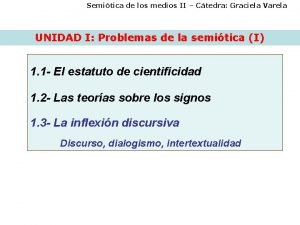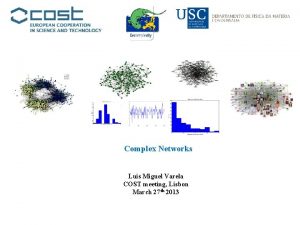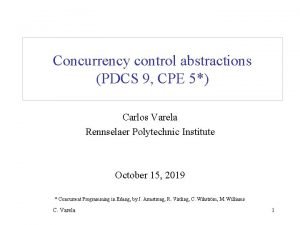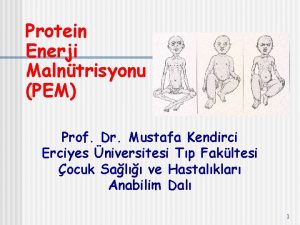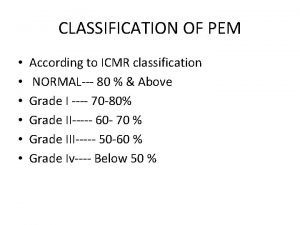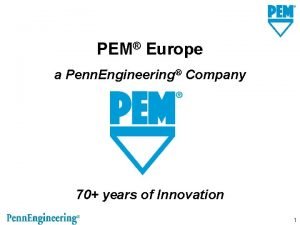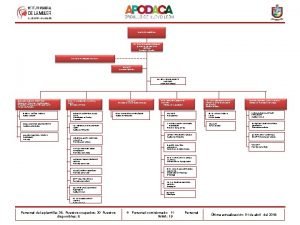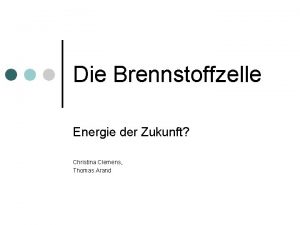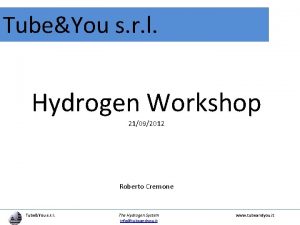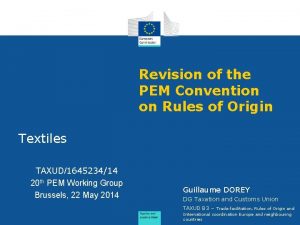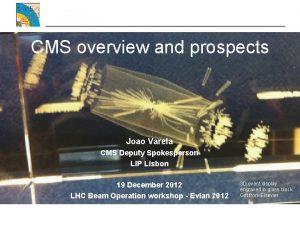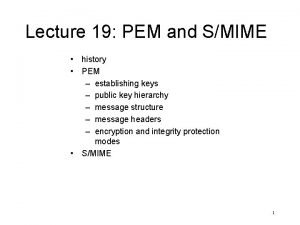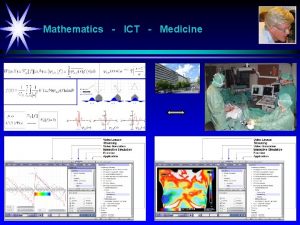Introduction to the Clear PEM projects Joao Varela






















- Slides: 22

Introduction to the Clear. PEM projects Joao Varela LIP, Lisbon On behalf of the Clear. PEM Collaboration Jornadas LIP Universidade do Minho, 7 -9 January 2010

The Clear. PEM Projects High performance PET scanner for breast cancer detection. Scanner is in clinical tests. Other applications to brain imaging and PET animal are being pursued Projects developed by the Clear. PEM consortium, in the framework of Crystal Clear at CERN IP licensed to PETsys, SA

The Clear. PEM scanner Good spatial resolution ( ~1. 5 mm in whole Fo. V) • Fine crystal segmentation (2 x 2 mm) • Do. I measurement with good resolution (FWHM ~2 mm) • Dual APD readout of individual crystal pixels High Sensitivity ( ~ 40 cps/k. Bq in center Fo. V) • Long LYSO crystals (20 mm) • Two detector plates with large active area Reduced Random Background (~30%) • Large flux of single photons (up to 10 MHz) • Coincidence time resolution of ~4 ns FWHM

The Clear. PEM scanner

The Clear. PEM detector Two detector plates: • 6144 LYSO 2 x 2 x 20 mm 3 crystals § • 12288 APD pixel channels • Dual readout of crystal pixels for Do. I measurement • 160 x 180 mm 2 active area • Water cooling • 75% of detector channels presently installed

ASIC Performance Pulse Shape Response to test pulse • Amplifier rise time: 20 ns • Variation of baseline and pulse shape 1 -2% Noise • Pedestal RMS = 2. 2 ADC Counts = 5 ke. V • ENC = 1300 e- r. m. s. • Inter-channel dispersion ~ 8% Noise measurement

Data Acquisition Performance Trigger Performance • Events in coincidence up to 1. 5 MHz (This involves computation of energy and time, Compton grouping and transmission to the trigger processor) • Acquisition rate up to 0. 8 MHz (This involves readout of the event dataframe after issuing a trigger) • Disk storage rate ~ 400 MB/s • High performance useful for fast calibration runs • Needed for other PET applications

Ancillary Systems Cooling • Water cooling of detector plates at 18 o. C • Stability of temperature ± 0. 1 o. C Bias Voltages r. m. s. ~28 m. V 40 hours • Regulation of APD bias voltages on the detector heads (64 regulation channels) • Long-term stability of HV ~ 28 m. V rms

Energy Resolution Na-22 spectra summed for all crystals Energy measurements: 137 Cs Resolution ~12. 5% • Average energy resolution at 511 ke. V for the full scanner is 16. 0% • Dispersion of energy resolution of individual crystals is 8. 8% Photopeak measurements • Good energy linearity (~ up to few percent)

Time Resolution Typical pulse sampling Time measurement: 137 Cs 50 MHz sampling Resolution ~12. 5% • Photon time is extracted from the pulse samples fitted by the function: Time difference in coincidence events All scanner coincidences • Coincidence time resolution of the whole scanner is 5. 2 ns FWHM

Do. I Resolution Asymmetry distributions for different impact points in the crystal Depth of interaction measurement • Do. I is measured from light asymmetry in crystal dual readout • From direct measurement (collimated photons): Do. I resolution ~ 2 mm FWHM for light asymmetry ± 40% Energy in bottom vs top APDs • Lu-176 background in crystals is used for Do. I calibration in whole scanner • Average light asymmetry is ± 59%

Energy Dependence on Do. I Photopeak position as a function of Do. I 137 Cs Resolution ~12. 5% Energy is independent of Do. I: E[ke. V]=Kabs. (Etop+Krel. Ebottom) Z[mm]=CDOI. ((Etopkrel. Ebottom)/(Etop+krel. Ebottom)) • Photopeak position is independent of Do. I (up to few percent) Energy resolution as a function of Do. I • Energy resolution does not depend on Do. I

Scanner Calibration Distribution of energy calibrations Energy: • Dispersion of channel gains 15. 3% ~4600 crystals Depth of interaction (Lu-176 background): • Dispersion of Do. I calibration constants 7. 8% Distribution of pulse peak time Time calibration: • Two pulse shape parameters per channel • Dispersion of time calibration constants 2% ~4600 crystals

Clear. PEM Sensitivity measurement: • Na-22 source A(22 Na) = 2. 73 µCi ± 0. 3% (101 k. Bq) Count rate scan • Sensitivity at center of Fo. V for 10 cm Detector Head opening is 1. 0% (350 -700 ke. V, 20 ns) • Correction factors: • Incomplete (75%) detector: 1. 3 • In-detector Comptons: ~2 Sensitivity (100 mm ): 1. 0% • Corrected sensitivity: ~2. 6% • Monte Carlo estimation: 3. 1% 14

Clear. PEM Spatial Resolution With Do. I Point source imaging • • Na-22 point source in a grid with 5 mm pitch Energy window 400 -600 ke. V Sinograms of 16 source positions are added Reconstruction with 3 D-OSEM / STIR 5 mm 1 mm Spatial resolution • Transaxial 1. 2 mm FWHM (corrected for source size ~1 mm) Do. I effect • Images without using Do. I information show considerable blurring Without Do. I

Clear. PEM Image Uniformity Images of uniform Ge-68 source • Reconstruction with 4 orientations of the detector plates Cylinder filled with positron emitter Ge-68 • Absorption, scatter and corrections are not applied • Image artifacts due to detector effects are corrected • Good image uniformity EW=400 -700 ke. V TW=4 ns 6 iterations 3 D-OSEM

Clinical Tests Program Scanner Installation • Hospital IPO, Porto Clear. PEM scanner at IPO Porto Phase 1 (present) • Patients indicated for PET/CT (other disease) • Negative breast exams • Tuning the image reconstruction with real cases • 11 exams done Phase 2 • Patients with positive indication from xrays mammography • Assessment of PEM sensitivity / specificity • Comparison to mammography and MRI

Initial clinical exams Example of typical exam: Reconstruction: • • 3 D-OSEM • randoms, attenuation and scatter corrections not applied • simple normalization correction • on-going work to reduce statistical noise dose 8 m. Ci 150 mm detector plate opening 4 angular orientations coincidence window ± 4 ns energy window 400 -650 ke. V fraction of randoms in Fo. V is 35%

Clear. PEM and Ultrasound § Dualmodal PET – US Clear. PEM-Sonic § CERIMED , Hospital Marseille, other partners § Ultra-sound probe with elastography capabilities § Cross-reference system and PETUS image fusion § Construction of second Clear. PEM machine is well advanced

PET Animal § Pre-clinical studies with small and medium size animals § PET/MR insert § Texas Institute of Preclinical Studies § Application to brain imaging /EPFL 35 cm 60 cm 4. 5 cm Cooling plates Detector modules Version with Do. I

High performance PET Improvements to Electronics/DAQ • Optical S-link (under test) • ASICv 4 (in design) • Intelligent Front End Board (in project) • PET Ring Trigger (hw ready) PET Time-of-Flight (FWHM ~200 ps) • Si. PM and TOF ASIC (collaboration with Torino and CERN) • SPAD single-photon detectors integrated with TDCs (collaboration with TUDelft and CERN)

The Clear. PEM Collaboration E. Albuquerque 1, F. G. Almeida 2, 13, P. Almeida 3, E. Auffray 10, J. Barbosa 2, A. L. Bastos 9, V. Bexiga 1, R. Bugalho 4, C. Cardoso 4, S. Carmona 8, J. F. Carneiro 2, B. Carriço 4, C. S. Ferreira 4, N. C. Ferreira 5, M. Ferreira 4, M. Frade 4, F. Gonçalves 1, C. Guerreiro 5, P. Lecoq 10, C. Leong 1, P. Lousã 6, P. Machado 1, M. V. Martins 3, N. Matela 3, R. Moura 4, J. Neves 4, P. Neves 6, N. Oliveira 3, C. Ortigão 4, F. Piedade 6, J. F. Pinheiro 4, P. Relvas 6, A. Rivetti , P. Rodrigues 4, I. Rolo 4, A. I. Santos 8, J. Santos 2, M. M. Silva 1, S. Tavernier 11, I. C. Teixeira 1, 9, J. P. Teixeira 1, 9, J. C. Silva 4, 10, R. Silva 4, A. Trindade 4, J. Varela 4, 12 1 INESC-ID, 2 INEGI, 3 IBEB/FCUL, 4 LIP, 5 IBILI/FMUC, 6 INOV, 8 HGO, 9 IPO, 10 CERN, 11 VUB Funded by
 Graciela varela castro
Graciela varela castro Varela materiais de construção
Varela materiais de construção Cristian varela psicologo
Cristian varela psicologo álvaro varela de ugarte
álvaro varela de ugarte Varela rpi
Varela rpi Fernando varela bohórquez
Fernando varela bohórquez Luis miguel varela
Luis miguel varela Noel varela
Noel varela Carlos varela rpi
Carlos varela rpi Antonio varela
Antonio varela Regalar una flor
Regalar una flor äänityypit
äänityypit Vicky varela
Vicky varela Carlos varela rpi
Carlos varela rpi Pem dereceleri
Pem dereceleri Privacy enhanced mail
Privacy enhanced mail Grading of pem
Grading of pem Pem komplikasyonları
Pem komplikasyonları Penn engineering pem
Penn engineering pem Elsa escobedo vazquez
Elsa escobedo vazquez Christina clemens
Christina clemens Pem electrolyser
Pem electrolyser Pem revision
Pem revision
